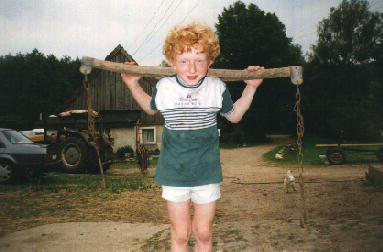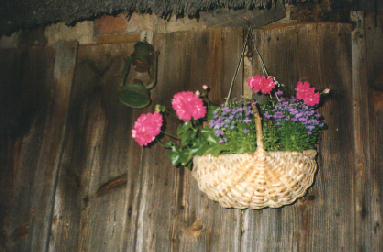Our village - "Farmhouse"
report...
300 year old, Kashubian hut - the one that is older
than that in Wdzydze museum!!!
 |
Kaszuby's culture, common for Polish coast, is rich in original for this region clothes, embroideries, and customs. One from few, really old cradle of this culture is an inhabited hut, probably originating from XVII century.
DATING: After World War II, during a routine renewal, there was discovered the beam with date, pointing that the hut is about 300 years old. In spite of intensive searching, beam is unable to find it now, but if spoken report is unchanged since World War II, and date on a beam was the date of the house orginating, than it is really so old.
LOCATION: The hut is located in Gdansk
district, near the city of Koscierzyna, in Pierszczewko village and it
is numbered 64, although there is also older number 39. It lies near the
crossroads to villages: Krzeszna, Pierszczewo, and Czaple. The hut is located
near coasts of the two beautiful post-glacial lakes: Patulskie and Ostrzyckie;
it is placed in a graceful comfortable site, what previous inhibitants
understood very well and located an inn in it. This location has also disadventage:
the hut is exposed to the humidity comming from lakes, what causes very
frequent need to repairing and replacing of it's demaged parts. Around the hut there are beautiful woods and meadows, dream
for tourists, who are visiting this region, called Kashubian Switzerland,
attracting by beauteful and still not polluted nature (Golubie, Szymbark,
Mount Wiezyca 329 m, multitude lakes). Unfortunately, owner of the hut
don't allow to visit it by visitors; anyway one can admire it from the
road. Inside the hut the owner and his family live in normal life of kaszubian
village. In spite of it's ancient status, hut is equipped to the normal
life rather then to inviting the visitors . Only in holidays time the hut
is full of accquintances and friends of the owners.
demaged parts. Around the hut there are beautiful woods and meadows, dream
for tourists, who are visiting this region, called Kashubian Switzerland,
attracting by beauteful and still not polluted nature (Golubie, Szymbark,
Mount Wiezyca 329 m, multitude lakes). Unfortunately, owner of the hut
don't allow to visit it by visitors; anyway one can admire it from the
road. Inside the hut the owner and his family live in normal life of kaszubian
village. In spite of it's ancient status, hut is equipped to the normal
life rather then to inviting the visitors . Only in holidays time the hut
is full of accquintances and friends of the owners.
HISTORY: The oldest hut's history is hidden in a history darkness. But the first grounded history of the hut begins from 1923 year, when farmer's grand-grandfather bought the hut. Since that time it was inhabited by four generations. Erlier hut's history - besides spoken report that there was an inn - are not revealed. Nowadays, the nine persons of farmer's family live in the hut: farmer whith his wife, their elders and few children. (besides a dog and a kitten...)
ARCHITECTURE: The roof is covered with
a thatch; walls construction: woodden framework, mad mixed with chaff,
outside covered with pine clapboards. Hut originally was covered by thatch,
typical for poor kaszubian farms. Nowadays owners continue this tradition,
changing roof cover every 20 years; a farmhouses are builded in the same
manner. Straw on the roof is covered by layer of reed, which is picked
from the nearest lake.  A
ceiling is based on beams 20 cm x 15 cm. Small windows whith one layer
of glass, nowadays made larger. Inside there is a window between the kitchen
and one of four rooms. During War II there was grenade trown to the kitchen,
but in-spite of explosion, the framework of the hut had not been destroyed.
A floor - in the kitchen made of bricks, in rooms - trashing floor (mad
+chaff). Owners cultivate a custom of covering the trashing floor with
the sand before every holidays. Tile ovens builded in a wall, for comfortable
heating a two or more compartment in the same time. Chimney stacks - only
parts of the hut made of bricks - joins at the loft in chamber from which
a smoke exhausts to the open air. The chamber is additionally used as a
smoke chamber for smoking such goods as fishes and other meet. A channel
black sediment must be removed every three months. There is an entrance
to the chamber from the loft. On the loft one can see the treenails, which
some time ago were used insted of nails.
A
ceiling is based on beams 20 cm x 15 cm. Small windows whith one layer
of glass, nowadays made larger. Inside there is a window between the kitchen
and one of four rooms. During War II there was grenade trown to the kitchen,
but in-spite of explosion, the framework of the hut had not been destroyed.
A floor - in the kitchen made of bricks, in rooms - trashing floor (mad
+chaff). Owners cultivate a custom of covering the trashing floor with
the sand before every holidays. Tile ovens builded in a wall, for comfortable
heating a two or more compartment in the same time. Chimney stacks - only
parts of the hut made of bricks - joins at the loft in chamber from which
a smoke exhausts to the open air. The chamber is additionally used as a
smoke chamber for smoking such goods as fishes and other meet. A channel
black sediment must be removed every three months. There is an entrance
to the chamber from the loft. On the loft one can see the treenails, which
some time ago were used insted of nails.
DAILY NECESSITIES: Inside the house there
are the old ferrule, the staples, the wooden chest, the 'carrier' for carrying
buckets with water, the wooden barrel, old coffee-mills, an ancient flat-iron with 'soul' and
a curler.
the wooden barrel, old coffee-mills, an ancient flat-iron with 'soul' and
a curler.
FARMER'S OCCUPATIONS: The first occupation
of owners is farmership, but they own olso an east part pf the Patulskie
Lake, hence besides of peasant farming they cultivate the "fish farm"
- as landlady named their fish breeding job. She herself decorates the
hut with preety, colourful plants in original kaszubian baskets made of
juniper roots. 
PLANTS: Behind the cowhouse there are two old limes, near the house - a big chestnut. The road to Krzeszna leads alongside of a lane with very old willows. In the garden there are fruit trees, wegetables and decoranting plants are cultivated by landlady.
Hut is writen into the National Register of Remains.
Information gathered, composed and took the pictures
Adam Skrzynecki, pupil of VI b class of SP1 in Gdynia, Poland
July 1997